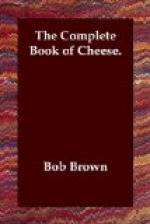2 teaspoons butter 2 cups grated cheese 1/2 cup soft bread crumbs 1 cup tomato soup Salt and pepper 1 egg, lightly beaten
Melt cheese in butter,
moisten bread crumbs with the tomato soup
and stir in; season,
add egg and keep stirring until velvety.
Serve on toasted crackers,
as a contrast to the bread crumbs.
Gherkin or Irish Rabbit
2 tablespoons butter 2 cups grated cheese 1/2 cup milk (or beer) A dash of vinegar 1/2 teaspoon mustard Salt and pepper 1/2 cup chopped gherkin pickles
Melt cheese in butter,
steadily stir in liquid and seasonings.
Keep stirring until
smooth, then add the pickles and serve.
This may have been called Irish after the green of the pickle.
Dutch Rabbit
Melt thin slices of
any good cooking cheese in a heavy skillet
with a little butter,
prepared mustard, and a splash of beer.
Have ready some slices
of toast soaked in hot beer or ale and
pour the Rabbit over
them.
The temperance version
of this substitutes milk for beer and
delicately soaks the
toast in hot water instead.
Proof that there is no Anglo-Saxon influence here lies in the use of prepared mustard. The English, who still do a lot of things the hard way, mix their biting dry mustard fresh with water before every meal, while the Germans and French bottle theirs, as we do.
Pumpernickel Rabbit
This German deviation is made exactly the same as the Dutch Rabbit above, but its ingredients are the opposite in color. Black bread (pumpernickel) slices are soaked in heated dark beer (porter or stout) and the yellow cheese melted in the skillet is also stirred up with brunette beer.
Since beer is a kind of liquid bread, it is natural for the two to commingle in Rabbits whether they are blond Dutch or black pumpernickel. And since cheese is only solid milk, and the Cheddar is noted for its beery smell, there is further affinity here. An old English proverb sums it up neatly: “Bread and cheese are the two targets against death.”
By the way, the word pumpernickel is said to have been coined when Napoleon tasted his first black bread in Germany. Contemptuously he spat it out with: “This would be good for my horse, Nicole.” “Bon pour Nicole” in French.
Gruyere Welsh Rabbit au gratin
Cut crusts from a half-dozen slices of bread. Toast them lightly, lay in a roasting pan and top each with a matching slice of imported Gruyere 3/8-inch thick. Pepper to taste and cover with bread crumbs. Put in oven 10 minutes and rush to the ultimate consumer.
To our American ears anything au gratin suggests “with cheese,” so this Rabbit au gratin may sound redundant. To a Frenchman, however, it means a dish covered with bread crumbs.
Swiss Cheese Rabbit




